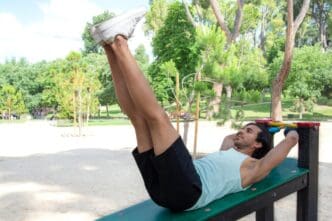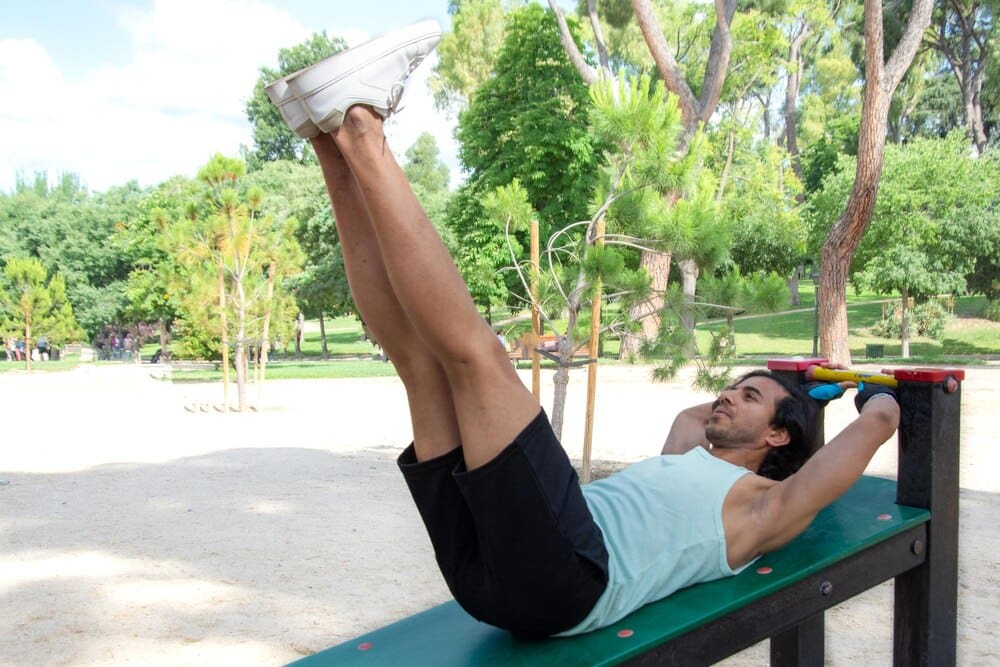For those in pursuit of the quintessential “Miami Beach Body”—a physique that radiates strength, confidence, and athleticism—the Turkish Get-Up (TGU) stands as one of the most powerful, all-in-one exercises you can master. This single, fluid movement, performed with a kettlebell or dumbbell, is a full-body crucible that forges stability, mobility, and raw strength from the ground up. It’s a favorite among elite trainers and athletes because it teaches the body to move as a single, integrated unit, building a resilient and aesthetically impressive frame by engaging nearly every muscle you have. By learning and practicing the TGU, you are not just lifting a weight; you are mastering a skill that builds a functionally powerful and visually striking physique ready for any challenge.
What is the Turkish Get-Up?
At its core, the Turkish Get-Up is a highly methodical, multi-step movement that takes you from a lying position on the floor to a full standing position—and back down again—all while holding a single weight locked out overhead. It’s not a fast or explosive lift like a snatch or a clean; rather, it’s a deliberate, graceful sequence that demands immense concentration and control.
Its origins are shrouded in fitness lore, often traced back to ancient Turkish wrestlers who used it as a test of strength and readiness. An old tale suggests that aspiring strongmen were required to perform a get-up with a heavy weight (upwards of 100 pounds) before they were even considered for training. While the history may be embellished, the exercise’s purpose remains clear: to build foundational, usable strength.
Unlike isolated exercises like bicep curls or leg extensions that target one muscle group, the TGU is a true compound movement. It forces your core, shoulders, hips, and legs to work in harmony, creating a chain of stability that protects the joints while building power across the entire body.
The Ultimate Beach Body Builder: Why the TGU is So Effective
The term “beach body” often evokes images of sculpted abs and toned shoulders. The TGU delivers on this aesthetic by building the functional foundation that creates that look. It’s not about superficial muscle; it’s about creating a body that is as strong as it looks.
Total-Body Strength and Conditioning
From the moment you press the weight to the moment you stand, every major muscle group is called into action. Your legs and glutes drive the movement from the floor, your core works overtime to keep your torso stable, and your shoulders, back, and arms work to support the weight overhead. This total-body engagement makes the TGU an incredibly efficient use of your time in the gym.
A Rock-Solid Core
If you want a defined midsection, you need to challenge your core to do what it’s designed for: stabilizing your spine against external forces. The TGU is arguably one of the best core exercises in existence. Throughout the entire movement, your abdominals, obliques, and lower back muscles are firing constantly to prevent your torso from twisting or bending, sculpting a strong and functional core.
Shoulder Stability and Health
Nothing says “strong physique” like a pair of broad, healthy shoulders. The TGU is a premier exercise for building shoulder health. By keeping the weight-bearing arm straight and stable, you are training the small stabilizing muscles of the rotator cuff to do their job correctly. This “packing” of the shoulder joint creates incredible stability, which not only prevents injury but also builds the deltoid and upper back muscles that contribute to a powerful V-taper.
Enhanced Mobility and Flexibility
A truly fit body isn’t just strong; it’s also mobile. The TGU moves your body through multiple planes of motion, improving flexibility and functional range of motion. You’ll increase mobility in your hips as you sweep your leg through, and you’ll enhance thoracic (upper back) spine rotation as you move from the floor to the lunge position. This added mobility helps you move better in all aspects of life and sport.
Improved Posture and Coordination
Modern life often leads to poor posture, with rounded shoulders and a forward head position. The TGU actively counteracts this. It forces you to maintain a tall, proud posture and align your joints correctly under load. Furthermore, the complex sequence requires intense focus, strengthening the mind-muscle connection and improving your overall coordination and body awareness.
Mastering the Move: Your Step-by-Step Guide
The key to the Turkish Get-Up is patience. Do not rush to add weight. Your first goal is to master the movement pattern itself. Practice every step using just your bodyweight, or by balancing a shoe or water bottle in your hand to learn the requisite stability. Perform each step slowly and deliberately.
Step 1: The Starting Position
Lie on your back in a fetal position next to the kettlebell. Roll onto your back and grip the kettlebell with both hands, bringing it to your chest. Press it up with your right hand, using your left hand to assist. Your right arm should be straight and locked, perpendicular to the floor. Your right knee should be bent with your right foot flat on the floor. Your left arm and left leg should be extended out to your side at roughly a 45-degree angle.
Step 2: The Roll to Elbow
Keep your eyes glued to the kettlebell. Drive through your right foot and push off your left heel to roll up onto your left elbow. The movement should be a powerful, diagonal crunch, not a sit-up. Your chest should be open and facing forward. Your right arm remains locked out and pointing to the ceiling.
Step 3: The Post to Hand
From your left elbow, push up onto your left hand. Your left arm should now be fully extended, creating a strong support post. You should feel a straight, stable line of force from the kettlebell in your right hand all the way down to your left hand on the floor. Keep your hips off the ground.
Step 4: The Hip Bridge and Leg Sweep
Lift your hips high toward the ceiling by driving through your right foot and left hand. This creates space to move. In a smooth motion, sweep your left leg back and under your body, placing your left knee on the floor directly under your hip. Your left knee should be roughly in line with your left hand.
Step 5: The Windmill to Lunge
Now, lift your left hand off the floor. Straighten your torso and organize your body into a stable, half-kneeling lunge position. Your front shin (right leg) should be vertical, and your back leg should be providing a stable base. At this point, you can take your eyes off the kettlebell and look straight ahead.
Step 6: The Stand
From this stable lunge, drive through your front foot to stand up completely. Bring your feet together so they are parallel, standing tall and proud with the weight held securely overhead. You have completed the first half of the movement.
The Descent: Reversing the Motion
The way down is just as important as the way up. You will reverse every step with the same deliberate control. From standing, step back with your left leg into a reverse lunge. Hinge at the hip and place your left hand on the floor (the “windmill”). Sweep your left leg through to the front. Lower your hips and come down to your left elbow, and finally, roll smoothly onto your back. Lower the weight safely to your chest with two hands before placing it on the floor.
Common Mistakes and How to Fix Them
Perfecting the TGU takes practice. Watch out for these common errors.
Rushing the Movement: The most common mistake is treating the TGU like a race. Solution: Pause for a second at each key position (elbow, hand, lunge) to ensure you are stable before proceeding to the next step.
Letting the Shoulder Sag: Allowing the weight-bearing shoulder to become loose or creep up toward your ear compromises stability and risks injury. Solution: Actively “pack” the shoulder by pulling the shoulder blade down and back, as if putting it in your back pocket.
Bending the Kettlebell Arm: A bent elbow indicates a loss of stability and control. Solution: Keep the arm locked by actively punching your fist toward the ceiling throughout the entire movement.
Looking Away from the Weight: Your eyes guide your body. Looking away from the weight too early can throw off your balance. Solution: Keep your eyes fixed on the kettlebell until you reach the upright lunge position (Step 5).
Programming the Turkish Get-Up
The TGU is versatile and can fit into your routine in several ways.
As a Warm-Up: Performing a few light TGUs per side is an excellent way to prime your entire body and central nervous system for a heavy workout.
As a Primary Strength Movement: Because it’s so demanding, the TGU can be the main event of your workout. Focus on low reps with a challenging weight. A typical “set” is often just one full rep per side.
As a Finisher: Performing TGUs at the end of your workout will challenge your stability and mental focus when you are already fatigued.
For reps and sets, quality trumps quantity. A great starting point is to aim for 5 minutes of continuous practice, alternating sides after each full repetition. As you get stronger, you can work up to 5 single, heavy reps per side with adequate rest in between.
The Turkish Get-Up is far more than just another exercise; it is a fundamental skill that builds a body that is resilient, powerful, and aesthetically balanced. While no single movement is a magic bullet for fitness, mastering the TGU is one of the most direct paths to developing the functional strength and confident posture that define a “beach-ready” physique. It’s a testament to the idea that the best way to look strong is to be strong, from the inside out.







